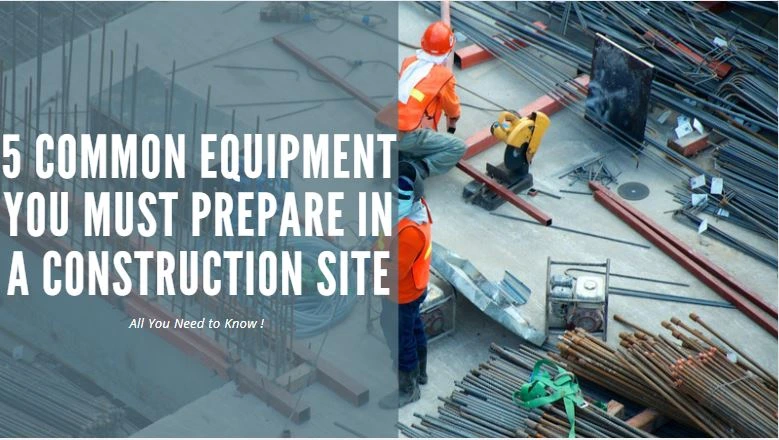5 Common Equipment You Must Prepare In A Construction Site

When people hear the term construction sites, they usually think of building sites where residential projects typically occur. However, one has to realize there are more classifications of construction sites. Apart from housing, a construction site is a term that also includes commercial, waste, transport, and power generation projects.
There are also more complex construction sites where specialized industrial projects occur, like nuclear plants and oil fields. Indeed, construction sites are some of the most dangerous places to work. Accidents on construction sites do not just affect those working in the area. Even motorists and pedestrians are at risk if the project is done in a public space.
As such, regardless of the type of project being done, employers and workers must take necessary safety precautions to avoid accidents. Proper training and equipment are required to lessen work hazards. For a safer workplace, here are five common pieces of equipment you must prepare at a construction site.
Traffic Cones
Traffic cones are a must in roadway construction sites. Due to their high visibility, the cones, usually fluorescent orange or red, are placed to create buffer zones. These zones help define pathways and separate workers from hazardous situations and oncoming traffic.
Different-sized traffic cones are used depending on the speed conditions of the area. In the United States, traffic cones range from 305 mm to 914 mm. To be sure, construction companies are advised to always check the law before acquiring traffic cones.
In Australia, the government requires the use of traffic cones sized from 450 mm to 500 mm on roads where traffic doesn't exceed 60 km/h. On the other hand, if the speed exceeds 60 km/h, the construction site should utilize 700 mm cones. Informally, Australian's often refer to traffic cones as witches hats.
Work Gloves
With the work they do every day, construction workers' hands are indeed highly vulnerable to injuries. In fact, according to the CDC, there are over a million hand construction injuries yearly in the US. That's nearly 3,000 hand-related accidents every day!
It may not seem much, but wearing proper work gloves could save you a trip to the emergency room. But how do you choose suitable gloves for the job? First, consider the material. For instance, use rubber gloves when working with chemicals and electrical protection tasks. For welding or general construction work, leather is a top choice.
Once you have chosen the right material, the next thing important to consider is fitting. Wearing ill-fitted gloves, compared to wearing none at all, pose a greater risk. Poor-fitting gloves cause hand cramping and blisters, hindering workers from doing their tasks safely.
Hard Hats
Some potential construction site hazards include falling objects, exposed electrical conductors, and flying parts from grinding and cutting operations. Thus, helmets or hard hats are required to be worn by workers to prevent them from getting injured.
According to guidelines, it is mandatory for workers such as linemen, electricians, and welders to use these helmets. And like all protective equipment, hard hats must fit well to the person wearing them. They should neither be too small nor large. Likewise, they should not slip, fall off, bind or irritate one's skin.
Depending on the job of the worker, there are specialty hard hats that come with different attachments. Some examples are light attachments, face shields, and reflective stripes for night visibility.
Safety Harness
Falls are the top cause of construction site accidents that lead to serious injury or death. To prevent this, employers must provide safety harnesses to anyone working more than two meters above the ground, like roofers and powerline workers.
It is important to note that safety harnesses are only one part of the fall arrest system. There is also the connecting device that attaches the harness to the anchorage. Together, they protect the wearer from falling to the ground during an accident.
Aside from fall protection, safety harnesses also improve the workers' comfort and productivity. Since working at high places may require construction workers to position their bodies at awkward and dangerous angles, safety harnesses will give them peace of mind to do their work without worrying about falling.
Foot Protection
There are various footwear that can protect workers' feet from harm. Foot injuries commonly happen when someone is working with heavy or sharp objects. Additionally, people who work on slippery or hot surfaces are also at risk of getting their feet hurt.
An example of such protective gear is metatarsal guards, which can either be strapped inside or outside regular shoes to help protect the upper foot area. There are also insulated shoes, which are ideal for workers assigned to work in extreme temperatures.
Final Thoughts
Inadequate planning, training, and equipment in a construction site pose a threat to the workers and the public. Not only that, but accidents also mean wasted resources and, possibly, a lawsuit too. Thus, employers must always strictly comply with the guidelines to keep everyone safe.
